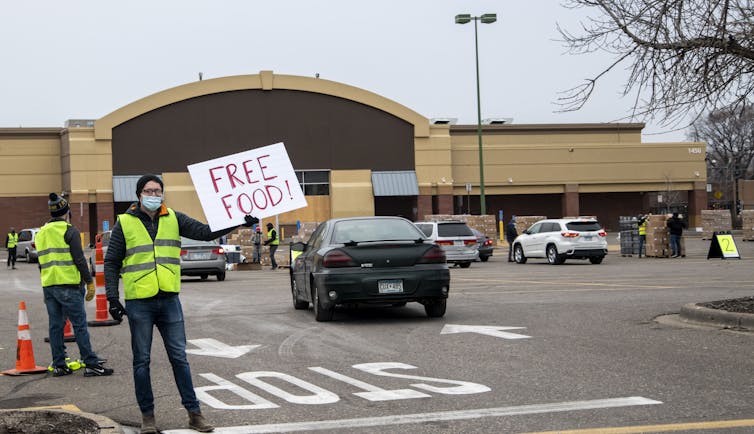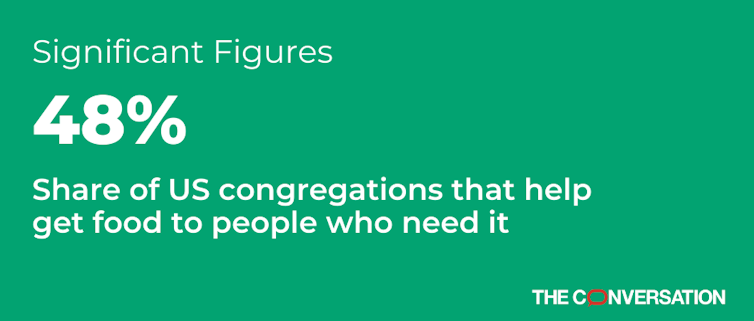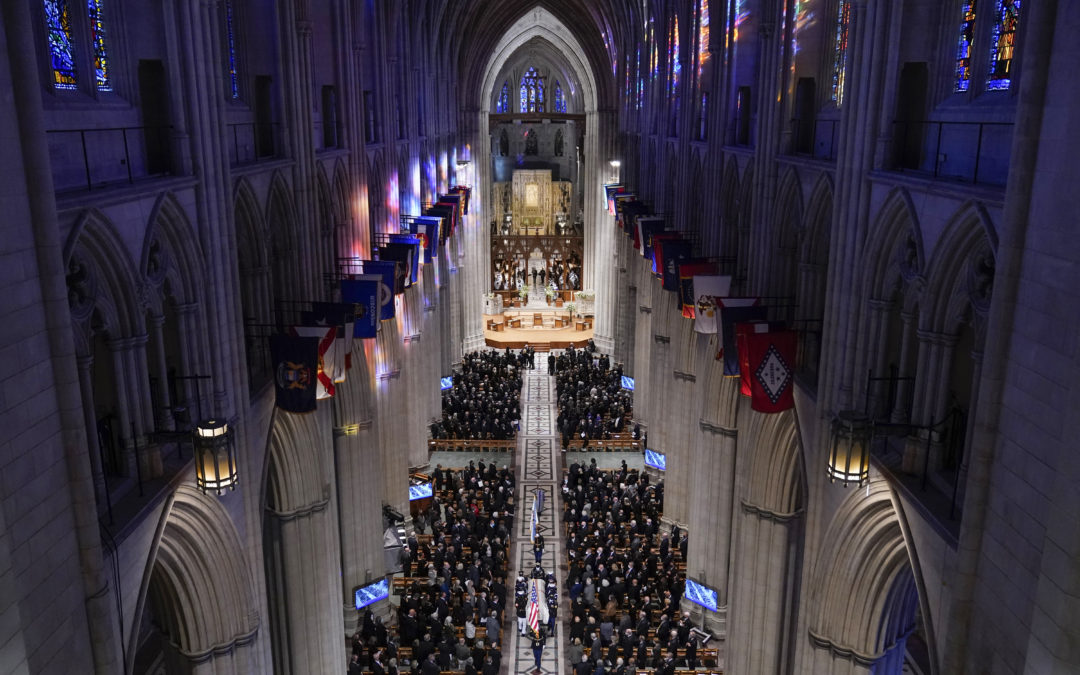
by Adelle M. Banks, RNS | Nov 9, 2021 | Commentary, Headline News |
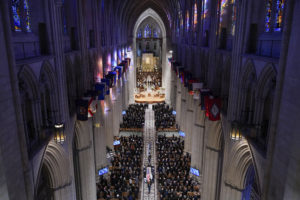 (RNS) — Former Joint Chiefs of Staff Chairman Colin Powell, known as a four-star general and as a onetime secretary of defense, was remembered at his funeral at the Washington National Cathedral Friday (Nov. 5) as a man of the Episcopal faith.
(RNS) — Former Joint Chiefs of Staff Chairman Colin Powell, known as a four-star general and as a onetime secretary of defense, was remembered at his funeral at the Washington National Cathedral Friday (Nov. 5) as a man of the Episcopal faith.
Longtime colleague and friend Richard Armitage, who served as deputy secretary of state under Powell, recalled how their regular 7 a.m. morning calls shifted to 9:30 on Sunday mornings, after his supervisor had returned from church.
“Colin loved the church: He loved the ceremony. He loved the liturgy. He loved the high hymns, which made him extremely happy,” said Armitage, who served with Powell in the State Department during the George W. Bush administration, during the private ceremony that was livestreamed on YouTube.
“And he would answer the same way every Sunday. He said, ‘Oh yes, I was at church. And I want you to know I’m in the state of grace.’ And I would answer the same way every Sunday: ‘Colin, if you’re not in the state of grace, who among us is?’ And that was every day for almost 40 years, the same opening remarks.”
Powell, who died Oct. 18 from COVID-19 complications, was honored at a nearly two-hour private ceremony. Hundreds of people gathered under the cathedral’s neo-Gothic arches, including President Biden and two former presidents, Barack Obama and George W. Bush, and their wives, and former Secretary of State and first lady Hillary Rodham Clinton.
“With faith in Jesus Christ, we receive the body of our brother Colin Luther Powell for burial,” said Episcopal Church Presiding Bishop Michael Curry, who met the general’s casket at the doors of the cathedral with Bishop Mariann Edgar Budde, leader of the Episcopal Diocese of Washington.
Some family members of Powell, 84, had key roles in the service that mixed the high church liturgy of the cathedral with the military precision of uniformed service members bearing Powell’s coffin and escorting his family.
His son, former Federal Communications Chairman Michael K. Powell, gave a tribute, along with Armitage and former Secretary of State Madeleine Albright, who preceded Powell in that position. His daughter, Annemarie Powell Lyons, read from the Hebrew Bible’s Book of Micah: “And what does the Lord require of you but to do justice, and to love kindness, and to walk humbly with your God?”
The Rev. Stuart A. Kenworthy drew on that Scripture as he spoke of Powell’s faith.
“Colin knew his God through all his years,” said Kenworthy in his homily, a role the former Army National Guard chaplain also played at the 2016 funeral of former first lady Nancy Reagan. “His faith was of first importance, and his life was marked by those words of the Prophet Micah.”
He also encouraged those remembering Powell to embrace their Christian faith.
“God raised Jesus so that you and I might share in his resurrection, and if you turn to him and accept him in faith, he will come into you and raise you into that new and eternal life now,” Kenworthy preached. “Just as he has for your beloved Colin, who now stands upon another shore and in a greater light, with that multitude of saints that no mortal can number.”
Prior to the homily, the Rev. Joshua D. Walters, rector of the Powell family’s church in McLean, Virginia, read words of Jesus from the Gospel of John: “Do not let your hearts be troubled. Believe in God, believe also in me.”
Congregants, masked during the continuing pandemic, stood to sing the hymns “Joyful, Joyful, We Adore Thee” and “Precious Lord.” Soloist Wintley Phipps sang “How Great Thou Art.”
In an earlier statement issued after Powell’s death, Curry noted Powell was a lifelong Episcopalian.
“I pray for his family and all his many loved ones, and I give thanks for his model of integrity, faithful service to our nation and his witness to the impact of a quiet, dignified faith in public life,” the presiding bishop said at the time. “He cared about people deeply. He served his country and humanity nobly. He loved his family and his God unswervingly.”
Though not generally known for his ties to religion, Powell was noted for comments he once made about then-Senator Obama’s faith.
Obama, in a statement released on the day of Powell’s death, spoke of his deep appreciation of Powell’s endorsement of his presidential candidacy when the general had been affiliated with past Republican administrations.
“At a time when conspiracy theories were swirling, with some questioning my faith, General Powell took the opportunity to get to the heart of the matter in a way only he could,” said Obama in the statement, referring to rumors that he was a Muslim.
At the time, Powell said, “The correct answer is, he is not a Muslim; he’s a Christian.”
But then Powell added a follow-up: “But the really right answer is, ‘What if he is?’ Is there something wrong with being a Muslim in this country? The answer’s no, that’s not America. Is there something wrong with some 7-year-old Muslim-American kid believing that he or she could be president?”
Powell also was among the top picks of likely voters who were religious and considering potential vice presidents when the then-senator was seeking the presidency in 2008.
But Armitage and other speakers mostly put politics aside as they recalled the man who was their friend, family member or colleague.
The former deputy secretary of state noted he and Powell had different preferences for hymns. Armitage recited the final verse of “Rough Side of the Mountain,” which speaks of standing “before God’s throne” when the race of life has concluded.
“Be real quiet,” Armitage told the congregation. “Listen real carefully. And you might hear our savior say, ‘Colin, welcome home. And here’s your starry crown.'”

by Chelsea Adams, MyCarolinaLife | Nov 5, 2021 | Headline News |

This article was originally published on MyCarolinaLife.com
RELATED: Good nutrition can contribute to keeping COVID-19 and other diseases away
When it comes to advice for managing your weight, it can be hard to separate fact from fiction.
Does drinking a concoction of maple syrup and cayenne pepper in place of meals really help you lose weight? Should you eat cabbage every meal? What about adding butter to your coffee – does that actually work?
Tidelands Health family medicine physician Dr. Vasudha Jain, who practices at Tidelands Health Family Medicine at Holmestown Road, says unorthodox plans to maintain or lose weight generally don’t work, and they can actually be dangerous to your health.
Instead of opting for quick-fix schemes, Dr. Jain says to look for a weight-management strategy that’s sustainable and backed by evidence-based research.
“There are lots of ideas out there,” Dr. Jain says. “But it’s important to evaluate the science behind them to determine how and why the strategy works.”
Important for health
For example, research has shown that eating a moderate amount of nuts every day is a great way to help maintain or lose weight while improving overall nutrition.
“Replacing sugary snacks with a handful of almonds or pecans is a simple strategy that can prevent gradual weight gain and aid in weight loss,” Dr. Jain says. “Nuts offer tons of nutrients and antioxidants as well as healthy fats and fiber, which can help keep you feeling full.”
Maintaining a healthy weight is important for overall health, Dr. Jain says, because it can help reduce your risk for a broad range of conditions, including:
• Heart disease
• Diabetes
• Stroke
• Some cancers
• Arthritis
• Gallstones
• Asthma
• Sleep apnea
“As we age, it can become harder to keep the pounds off. Adults tend to gain 1 to 2 pounds each year, so finding effective ways to keep your weight in check becomes especially important,” she says.
In addition to eating nuts, here are 10 more tips that can help manage your weight:
1. Drink water before meals
People who used this strategy lost more weight than those who didn’t. Thirst often masks itself as hunger, causing you to eat more than you should. Additionally, drinking water beforehand makes you feel fuller so you eat less during the meal.
2. Move often
Physical activity and movement are key to preventing weight gain and maintaining good cardiovascular health.
3. Be selective when eating out
The average restaurant meal totals more than 1,000 calories, but nutritional information is often not printed on menus. Look for ways to lessen your caloric intake when dining out. Split a meal or substitute starchy side dishes with a green salad.
4. Stay hydrated
In addition to drinking water before meals, it’s important to stay hydrated throughout the day. Increasing your water consumption will boost your metabolism by as much as 30 percent, which can help you burn extra calories as you go about your day.
5. Eat protein for breakfast
Research has shown that replacing a grain-based breakfast like oatmeal or muffins with protein, specifically eggs, will cause you to eat fewer calories for the next 36 hours. You’ll feel fuller throughout the day, so you’ll snack less and eat smaller meals at lunch and dinner.
6. Use smaller plates
Studies have shown that using smaller plates during meals help you eat less food. Called the Delboeuf illusion, your brain is tricked into thinking you’ve eaten a larger portion.
7. Rearrange your plate
Speaking of plates, aim to fill half your plate with vegetables, a quarter with whole grains and a quarter with lean protein. The Choose My Plate app available through the U.S. Department of Agriculture makes it easy to track how much you’re eating from each food group.
8. Get enough sleep
Adequate sleep is extremely important to maintaining a healthy weight. Lack of sleep can prompt your body to produce more of a hormone that increases hunger and less of a hormone that makes you feel satisfied. Therefore, you crave more salty and sweet foods. That’s why poor-quality sleep has been linked to an 89 percent increased risk of obesity in children and a 55 percent increased risk of obesity in adults.
9. Don’t drink calories
Sugary drinks like sodas and juices contain lots of empty calories that can lead to weight gain. In fact, liquid sugar may be the most fattening aspect of our diets. One study found that sugar-sweetened beverages increased the risk of childhood obesity by 60 percent.
10. Chew and eat slowly
Take your time when eating. One study has found that chewing 50 times per bite of food can reduce your caloric intake. Additionally, eating slowly will make you feel fuller more quickly.
Maintaining your weight requires dietary changes and lifestyle modifications — not fad diets. By implementing at least some of these evidence-based tips in your daily life, you’ll find it easier to manage your weight and improve your health.
by Adelle M. Banks, RNS | Nov 4, 2021 | Black History, Headline News |
(RNS) — Two and a half centuries ago, Francis Asbury arrived in the United States from Great Britain, bringing with him what would become the Methodist faith. He went on to spread it across the country, with St. George’s Church in Philadelphia as his home base.
St. George’s will mark the occasion of Asbury’s arrival with a weekend of events at the end of October. But the historic church, which remains the oldest continually used Methodist building in the United States, is also the starting point of three African American churches and one denomination after a “walkout” by Black worshippers.
Over time, recounts the Rev. Mark Salvacion, St. George’s current pastor, African Americans —some recently freed from slavery — were segregated to the sides of the church, to the back of the building and to a balcony, preventing them from receiving Communion on the church’s main floor.
Salvacion describes this and other parts of St. George’s history in the church’s “Time Traveler” program for teen confirmation students learning about their faith and in classes of middle-age adults training to become certified lay ministers.
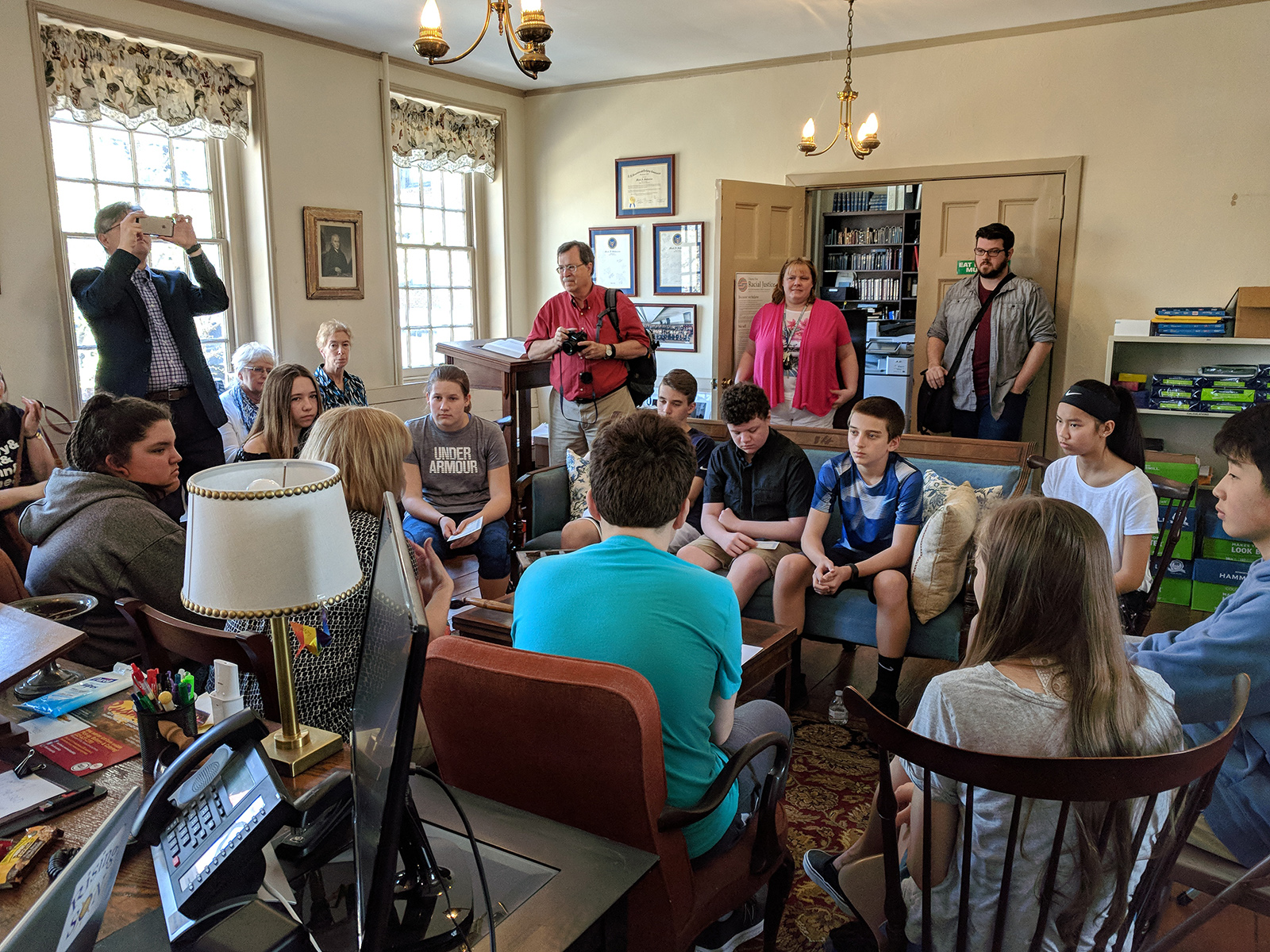
Teenage confirmation students attend a “Time Traveler” program at Historic St. George’s United Methodist Church in Philadelphia in 2018. Photo courtesy of HSG
“It’s not just telling happy stories about Francis Asbury itinerating to West Virginia,” said Salvacion, pastor of what is now called Historic St. George’s United Methodist Church. “It’s uncomfortable stories about race and the meaning of race in the United Methodist Church.”
The turning point for many African American worshippers, already dissatisfied with mistreatment, was a Sunday morning in the late 1700s. Lay preacher Richard Allen saw another Black church leader, Absalom Jones, forcibly pulled up while praying on his knees at St. George’s.
That led Allen and some of the other Black attendees to leave what was then known as St. George’s Methodist Episcopal Church and strike out on their own — in different ways.
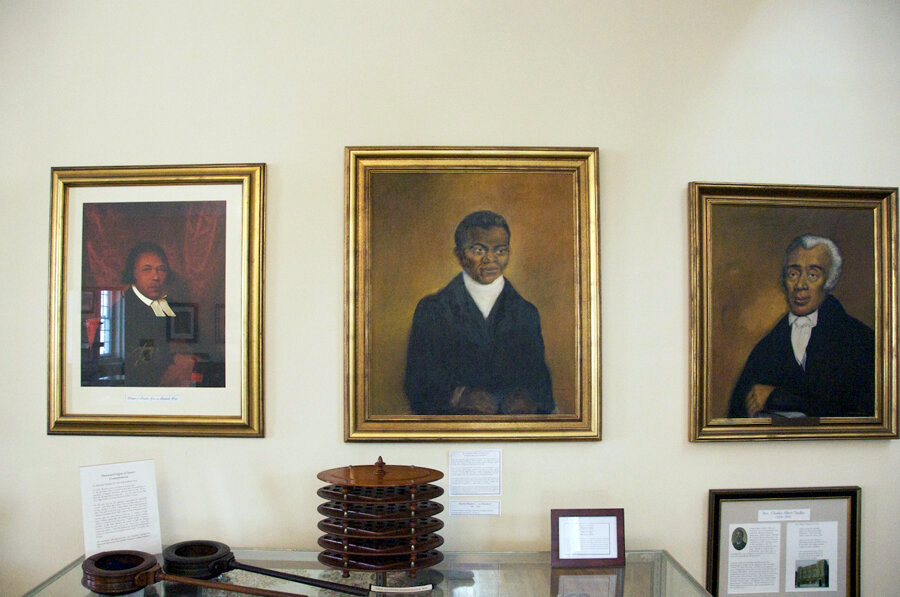
Portraits of Absalom Jones, from left, Harry Hosier and Richard Allen in Historic St. George’s United Methodist Church museum in Philadelphia. Photo courtesy of HSG
“This raised a great excitement and inquiry among the citizens, in so much that I believe they were ashamed of their conduct,” wrote Richard Allen in his autobiography. “But my dear Lord was with us, and we were filled with fresh vigour to get a house erected to worship God in.”
In 1791, Allen, who had been a popular preacher at St George’s 5 a.m. service, started what is now Mother Bethel African Methodist Episcopal Church. Asbury dedicated its first building, a former blacksmith shop, in 1794.
“Here’s Asbury and he comes in and he still has this kind of relationship with Richard Allen that is more than just collegial,” the Rev. Mark Tyler, current pastor of Mother Bethel, said of the men who were the first bishops of the Methodist and AME churches, respectively.
“I mean, you go out of your way as the representative and the saint of Methodism in America and you dedicate Mother Bethel. That is a statement that you’re behind this and endorsing it.”
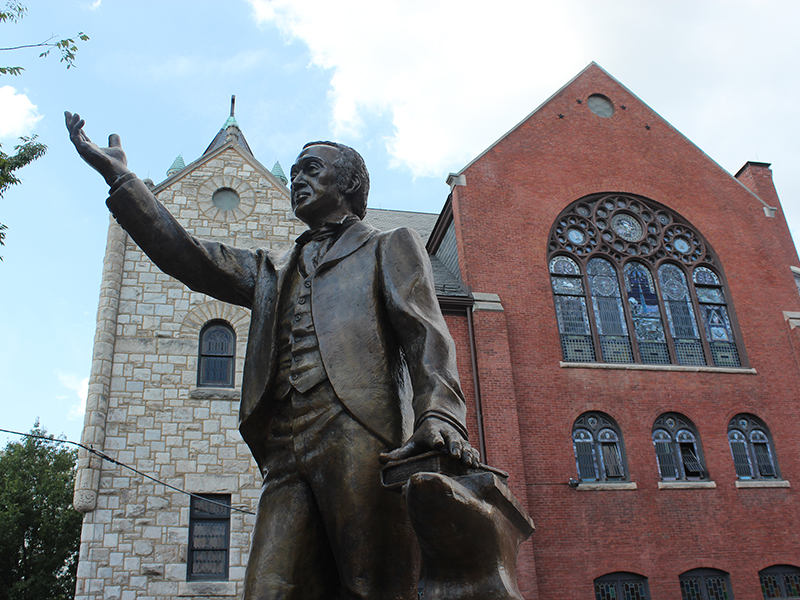
Bronze statue of Richard Allen, founder of the African Methodist Episcopal Church, on the property of Mother Bethel AME Church in Philadelphia on July 6, 2016. RNS photo by Adelle M. Banks
In 1816, after winning a court battle for its independence from the Methodist Episcopal Church, Allen started the African Methodist Episcopal Church, the nation’s first Black denomination.
Jones went on to serve as a lay leader of the African Church that began in 1792. Two years later, the congregation became affiliated with the Episcopal Church and was renamed the African Episcopal Church of St. Thomas. Jones was ordained a deacon in 1795 and a priest in 1802.
Arthur Sudler, director of the Historical Society & Archives at the 1,000-member church, said the 250th anniversary of Asbury’s U.S. arrival is significant not only for the three Philadelphia congregations that began after discord with St. George’s but also for the city and the three denominations they now represent.
“It’s an epochal moment simply because Francis Asbury’s role in helping develop Methodism in America, in part through his participation there at St. George’s, is one of those factors that gave birth to the Black Christian experience in Philadelphia,” he said. “And in America more broadly, because of the seminal role of Absalom Jones, Richard Allen, and Harry Hosier and their connections between what became these three denominations, the AME Church, the United Methodist Church and the Episcopal Church.”
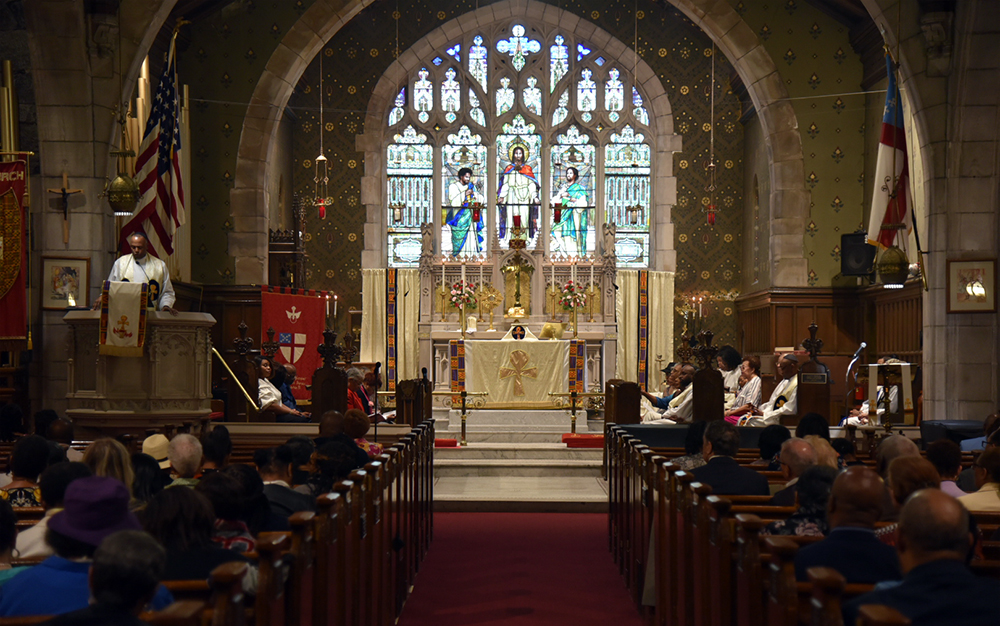
Service at the African Episcopal Church of St. Thomas in 2019. Photo by Dale Williams for D’Zighner Studios
Hosier initially stayed at St. George’s with other Black attenders who did not leave with Jones and Allen. He also was a closer colleague to Asbury than the other two men, having been a traveling companion who preached with the Methodist leader across the South. Allen, a free man, had declined the offer, avoiding a risky return to the region of the country where slavery remained legal.
Hosier helped found another Philadelphia Methodist congregation, which initially met in people’s homes and eventually became known as Mother African Zoar United Methodist Church. Asbury dedicated its building in 1796 and preached there a number of times, according to the United Methodist Church’s General Commission on Archives and History.
After it celebrated its 225th anniversary, Mother Zoar retained its name but merged with New Vision United Methodist Church in north Philadelphia, with a current average of 75 people at in-person worship services. It thus remains the oldest Black congregation in the United Methodist tradition in continuous existence.
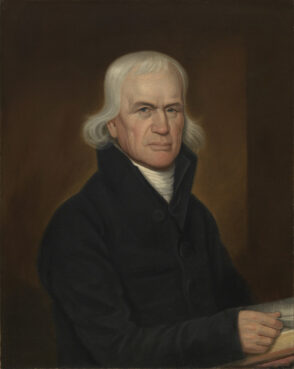
Portrait of Francis Asbury in 1813 by John Paradise. Image courtesy of National Portrait Gallery/Creative Commons
Given the steps of Allen and Jones, why did Hosier and other Black worshippers who once prayed at St. George’s remain within the Methodist Church?
“That is a million-dollar question,” said the Rev. William Brawner, the part-time pastor of Mother Zoar.
He said he assumes “those who left with Absalom, those who left with Richard were tired and figured that they could not change the system of injustice from the inside.” The founders of Zoar chose a different approach, hoping that remaining Methodist would help “change the hearts and minds of the people that were literally oppressing them.”
All these years later, Brawner said he does not judge the different decisions made by African American worshippers at St. George’s, who were unable to freely use spiritual practices that were different from those of white congregants and reflected beliefs some had brought with them from Africa.
“I think people left because of feeling uncomfortable and unaccepted in one place,” he said. “So the split could be celebrated now because of what has become of the split, but people didn’t split out of privilege. People split out of pain. They split because they were hurting.”
The emotions arising from the divisions transcended the centuries.
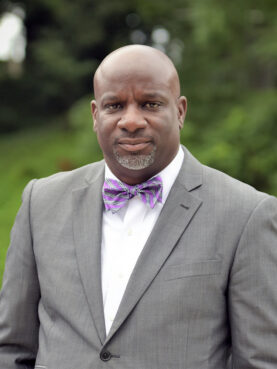
The Rev. Mark Tyler. Courtesy photo
Tyler, whose church has more than 700 members today, recalled the 2009 service when congregants of Mother Bethel worshipped at St. George’s for what was believed to be the first joint Sunday morning service since the 1700s. As the preacher for that day, he said the gathering was a “cathartic moment,” prompting many of his church’s members to weep.
Salvacion and the clergy of the other churches say occasional joint gatherings have continued since then, such as some of the congregations sharing Easter sunrise services and the annual Episcopal Church observance honoring Absalom Jones.
St. George’s currently has about 15-20 worshippers and a membership of about 50. It expects dozens of United Methodists and invited guests from other churches to attend the Oct. 30-31 commemoration.
Its pastor also expects exchanges and shared events will continue in the future among the congregations whose first members left his church building.
“We all view this history as being common history that we share,” said Salvacion, an Asian man who is one of St. George’s first pastors of color.
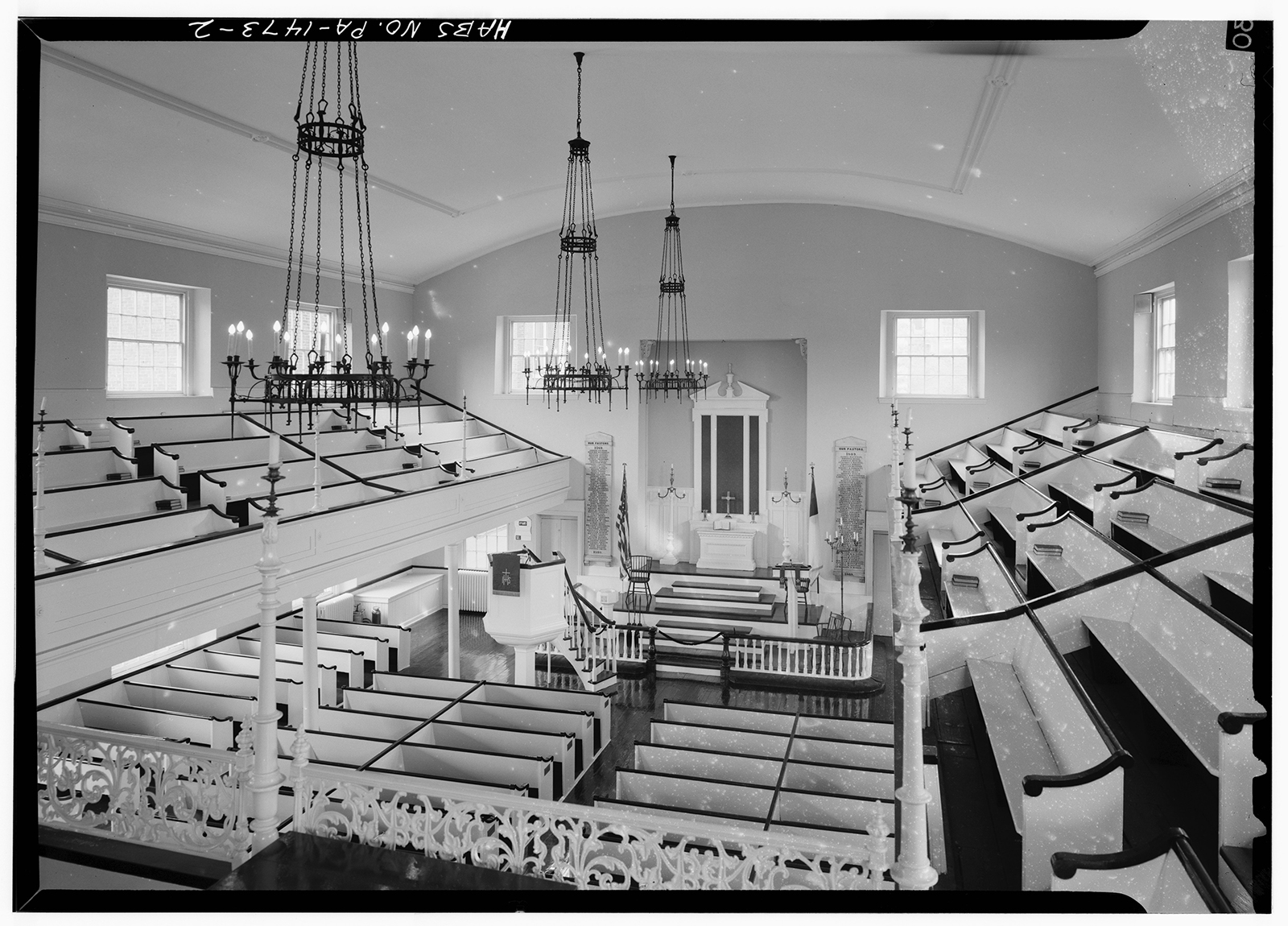
Interior of Historic St. George’s United Methodist Church in Philadelphia. Photo courtesy of LOC/Creative Commons
Tyler said the ongoing connections between St. George’s and Mother Bethel probably weren’t envisioned by anyone two centuries ago.
“The current relationship of these two congregations is, in some ways, a sign of hope for what’s possible,” he said. “If it can happen in these two congregations maybe it’s possible for us as a country and as a world. I have to take it for what it is — just a small sign of hope, in spite of all the kind of guarded optimism that I have.”
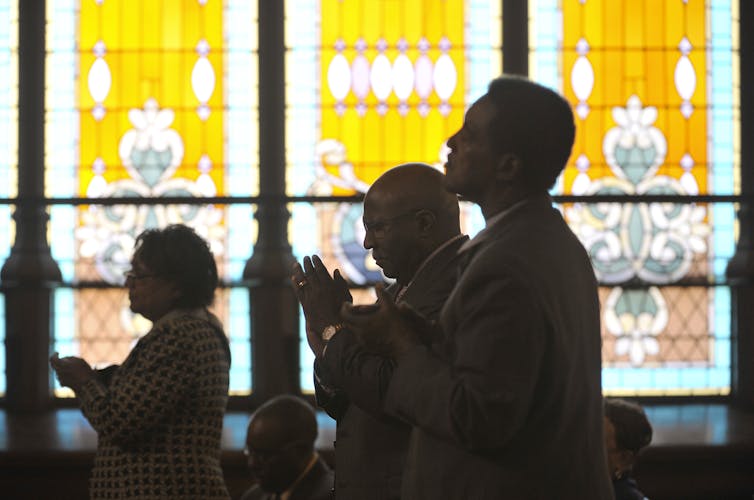

![]()


 (RNS) — Former Joint Chiefs of Staff Chairman Colin Powell, known as a four-star general and as a onetime secretary of defense, was remembered at his funeral at the Washington National Cathedral Friday (Nov. 5) as a man of the Episcopal faith.
(RNS) — Former Joint Chiefs of Staff Chairman Colin Powell, known as a four-star general and as a onetime secretary of defense, was remembered at his funeral at the Washington National Cathedral Friday (Nov. 5) as a man of the Episcopal faith.









